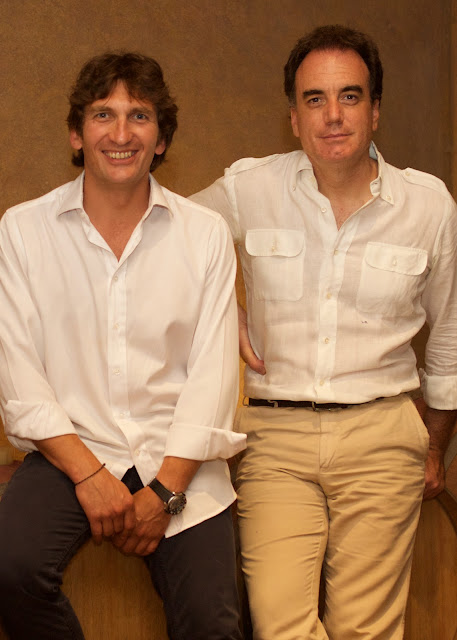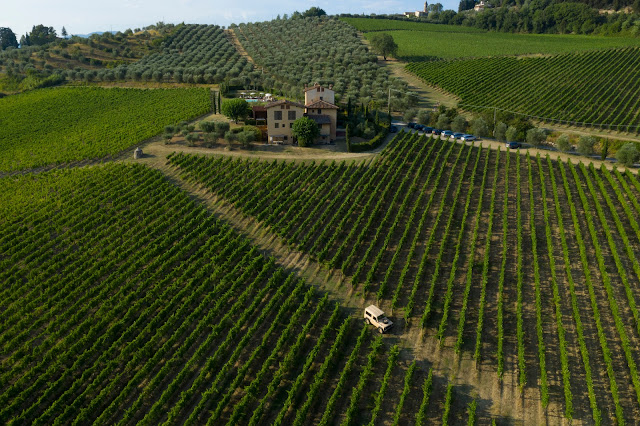We’ve made it to July, the half way point of the year, where our Italian Food, Wine & Travel group is featuring Tuscany hosted this month by Wendy of A Day in the Life on the Farm. I have some great wine Tuscan appellations lined up this month, starting with Chianti Rufina today. Many visitors flock to the Chianti Classico zone of Tuscany when visiting this region, but located just about 12 miles northeast of Florence is another one of Chianti’s gems, Chianti Rufina.
The region – Chianti Rufina
Chianti Rufina is located on the Apennine Mountains' foothills between the Sieve River. It is one of the 7 sub-appellations of the Chianti DOCG and the smallest of the group, but the one with the higher quality. Evidence dates that wine has been made there since the early 15th century. In 1716 the Grand Duke of Tuscany, Cosimo III, named the wines of Chianti Rufina among the best 4 in Tuscany. In 1931 the territory was defined and subdivided. It was upgraded to a DOC in 1967 and later into a DOCG in 1984.
Due to its proximity to the mountains this area is cooler than the Chianti Classico region and has great diurnal swings between day and night temperatures. The area's soils are primarily made of limestone, clay, and alberese. Most of the slopes face south to southwest and reach up to 400-500 meters above sea level (up to 1,600 feet)!
There are 5 communes within Chianti Rufina: Dicomano, Rufina, Pontassieve, Pelago, and Londa. Dicomano is the farthest north and has the highest altitudes, where those of Pelago in the southeast are the warmest commune with richer wines.
The Chianti Rufina Consorzio defines the wines as “elegant wine, with a strong personality, well-balanced tannin, and vivid acidity, the fragrance evokes a complex bouquet of berries and spice.” Compared to the wines of Chianti Classico, they are fruity, and elegant with fresh acidity but lacking in the body. These wines must make up a minimum of 70% Sangiovese with other added grapes including Canaiolo, Colorino, and no more than up to 15% Cabernet Franc and/or Cabernet Sauvignon.
The winery – I Veroni
I was part of a virtual tasting last fall on the wines of I Veroni, located within the Chianti Rufina territory. The owner, Lorenzo Mariani, and his childhood friend, Luca Innocenti, who is the marketing and sales director, led us through a tasting of their single vineyard with an overview of the region and history of the winery. The Mariani family founded the company over 300 years ago, in 1987 when Lorenzo’s great-grandfather first established it.
 |
| Left to right, Luca Innocenti and Lorenzo Mariani |
I Veroni has over 170 acres of land, with about 55 acres dedicated to vines and just as many acres dedicated to olive groves. When Lorenzo first joined the family business in 1996, the winery was producing 1,000 bottles, whereas today the production is over 150,000 bottles. Lorenzo also produced the winery's two single vineyard wines that I’m sharing today I Domi and Quona.
The wines
The 2021 I Veroni “I Domi” Chianti Rufina DOCG is made from 90% Sangiovese and 10% Canaiolo and Colorino. Labeled “vino biologico” due to I Veroni producing certified organic wines. The grapes are grown on 20-year-old vineyards located 250 meters above sea level (820 feet). The wine is aged for 1 year in big Slavonian barrels. A deep ruby red with aromas of cherry, white pepper, and a hint of bell pepper. A medium-bodied, dry wine that showed black cherry fruits, but I mostly felt like I was biting into a green olive. Good acidity and tannin that were rather elegant, considering I opened the bottle without any aeration and poured it right into my glass. ABV 14.5% SRP $19
The 2019 I Veroni “Quona” Chianti Rufina Riserva DOCG is what I Veroni considers their “grand cru” wine. This wine is made from 100% Sangiovese from 30-year-old vines 300 meters above sea level (about 980 feet). Quona is the name of the old church in the vineyard. This wine spends 18 months in French oak with 1/3 of it in new barrel, 1/3 in a barrel used for 1 vintage, and a 1/3 in barrels used for 2 vintages. with an additional 12 months in the bottle. Aromas of black cherry, and plums with a hint of licorice. Dry and medium-bodied with gripping tannin combined with tobacco and cherry notes. Although I will admit, I didn’t give this wine any time to aerate. ABV 14% SRP $30
Chianti Classico has over 300 producers compared to those of Chianti Rufina, that have about 2,5 so they do not produce on a large scale as their counterpart. Instead, focus on quality and the uniqueness of the Sangiovese grown there. The next time you seek a Chianti, try Chianti Rufina to experience the difference for yourself.
Check out the other Italian food and wine lovers as they share their choices on wines and foods from Tuscany this month.
- Camilla of Culinary Cam shares "Polpo in Galera (Jailed Octopus) + La Lastra Vernaccia 2021"
- Robin of Crushed Grape Chronicles talks about "The wines of the Florentines – Chianti Rufina and single vineyard wines from I Veroni"
- Wendy of A Day in the Life on the Farm enjoys "A casual bottle of Cetamura Chianti on the deck"
- Gwendolyn of Wine Predator finds "Paradise in Tuscany: Organic Farming at Antonella Manulli's Fattoria La Maliosa"
You will find plenty of Chianti Rufina and other Tuscan wines if you search Wine.com.



I love the different perspective on these wines! I was not familiar with the communes in Rufina, and now I want to dive further into learning about those!
ReplyDelete